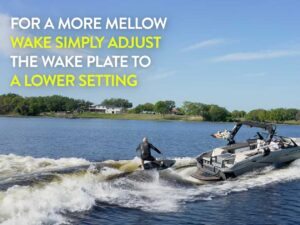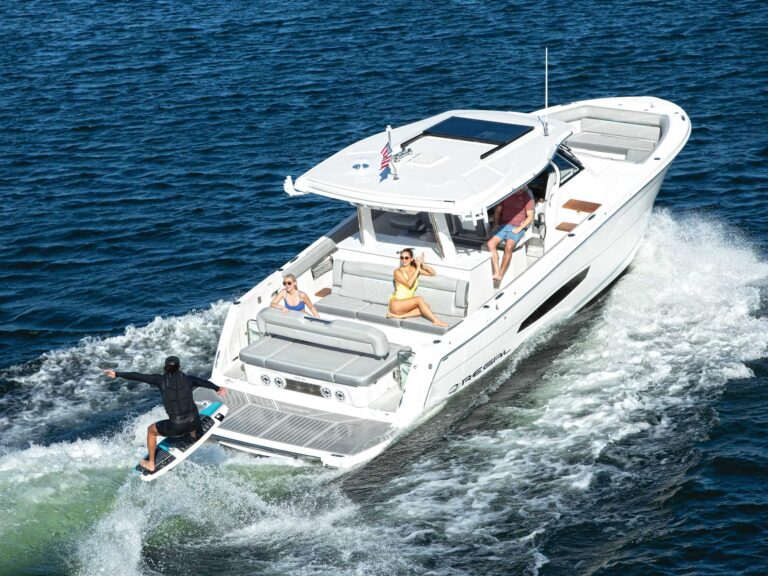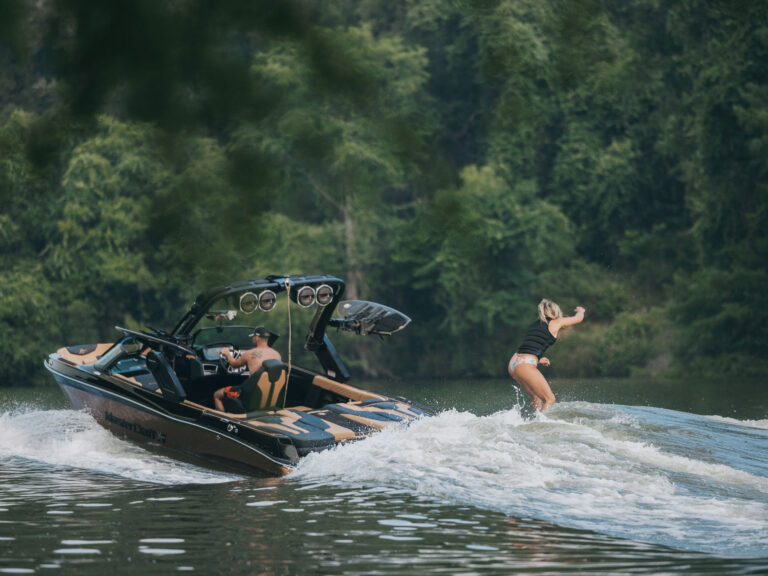The Best in Ballast: The Fine Art of Weighting Your Boat
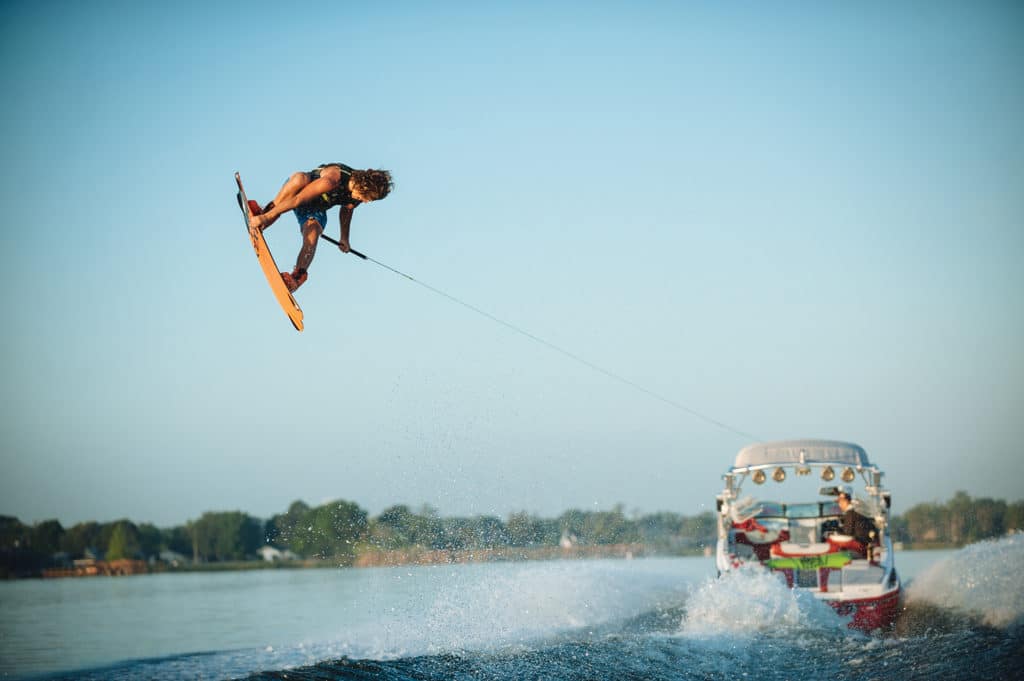
An unweighted boat to a high-level rider is like a partially deflated basketball to an NBA player, he’ll never be able to perform at his highest level with it. A properly weighted boat allows a rider with good technique to accomplish more wake-to-wake than the rest of us are praying for off the double-up. It provides the extra oomph that slams the boat down and jacks the wake up, and it truly is an art that’s cultivated over time. “A bigger wake makes everything easier,” says Trevor Hansen. “Not only are you able to do more tricks that you wouldn’t be able to do on a smaller wake, but it also makes your normal tricks that much easier and you don’t have to work as hard for them.”
“A big wake gives you that extra time in the air,” adds Steel Lafferty. “You can push your grabs longer and put that extra 180 in. It gives you that extra lip at the top of the wake that kicks you into the trick you want to do.”
Certain pro riders can walk up to an empty boat and determine in short order exactly what weight should go where and produce big, clean wakes more times than not. If you’ve ever had a fickle boat that washed out on one side when you shifted your phone 2 inches to the left or right, you know what a mystical and elusive art adding ballast actually is. But don’t worry because there’s a method to the madness. We’re here to pull back the curtain and take you behind the scenes to show you the ballast types and configurations the pros use in their respective flagship wakeboard boats to produce ramps upward of knee-high.
FORM EQUALS FUNCTION
First, a word of caution: A big wake is a glorious thing under the bindings of someone who knows how to handle it, but it’s not for beginners. “It would be like someone trying to learn football by hitting an NFL player instead of a practice pad,” says Adam Fields. “It’s really hard for beginners to jump from a normal boat to a fully weighted modern boat,” adds Chad Sharpe. “The new boats are so much heavier before you even put in ballast that it can be bad for beginners to throw too much weight in.” In other words, you can’t just hop straight off the couch after a long off-season and charge into a thigh-high wake with a raley cut because you’ve seen Sharpe do it. You have to work up to the legendary wakes most of us aspire to or you’re just asking for injury. And beyond injury, you may not even be getting the most out of your riding. “A big wake, a lot of times, lets you get away with improper technique,” says Shaun Murray. “Before we let students have weight in the boat, we have them ride without anything and make sure they have proper technique. If you’re using proper technique, whether you’re on a small wake or a big wake, you’ll take your riding to a whole new level. Otherwise, you’re just wasting gas.” So there you have it. Don’t weight your boat until you’re ready, and that includes factory ballast. There’s no shame in riding a small or medium-size wake and doing it well.
BALLAST BASICS
The addition of ballast to a boat is intended, principally, to sink the boat down so it can displace more water and create a bigger wake. That’s the easy part. The harder part is fine-tuning that wake to create crisp, clean launch ramps and landing zones with just the right amount of steepness. “Having the right distribution of weight is crucial to getting the best shape out of the wake,” says Dean Smith. “It may take a few sets to sort this out, but it will be worth it in the long run.” Generally, you’ll want the weight in the boat to stay fairly equal from side to side to get a symmetrical wake that’s approachable from both sides. Try to get it as even as you can, then play around with it. For example, if the wake is rolling over on one side, it’s as simple as moving weight to that side until it starts to clean up. The boat’s weight from bow to stern, however, is much more crucial. “Putting weight in the front of the boat will normally cause the wake to be less steep, and putting weight in the back will make the wake steeper, as a general rule,” says Hansen. This means if your boat tends toward the steep side and you want to mellow it out for longer landing zones and a less-vertical pop, try throwing some weight in the bow. The opposite is true for a long, flat wake with no pop. However, there’s always a case where these general rules may not hold true. “You’ve got to play around with it,” says Hansen. “There’s lots of different ways to weight a boat. All boats are kind of similar, but some boats are going to do better with weight in the front or the back or the middle.” Most modern boats have an integrated ballast system that’s easy to tweak and will get you to where you need to be in terms of even weighting. They also have options for pretty substantial ballast straight from the factory as well as dry weights that are heavier than ever, so they will be more than adequate for the majority of beginners straight off the showroom floor. But these guys are pros, and they can’t help themselves. The years of habitually weighting boats (and possibly the result of so many heel-edge hookups) have them engrained with the necessity of putting weight in their boats, and here’s how they do it.
SHAUN MURRAY — SUPER AIR NAUTIQUE G23
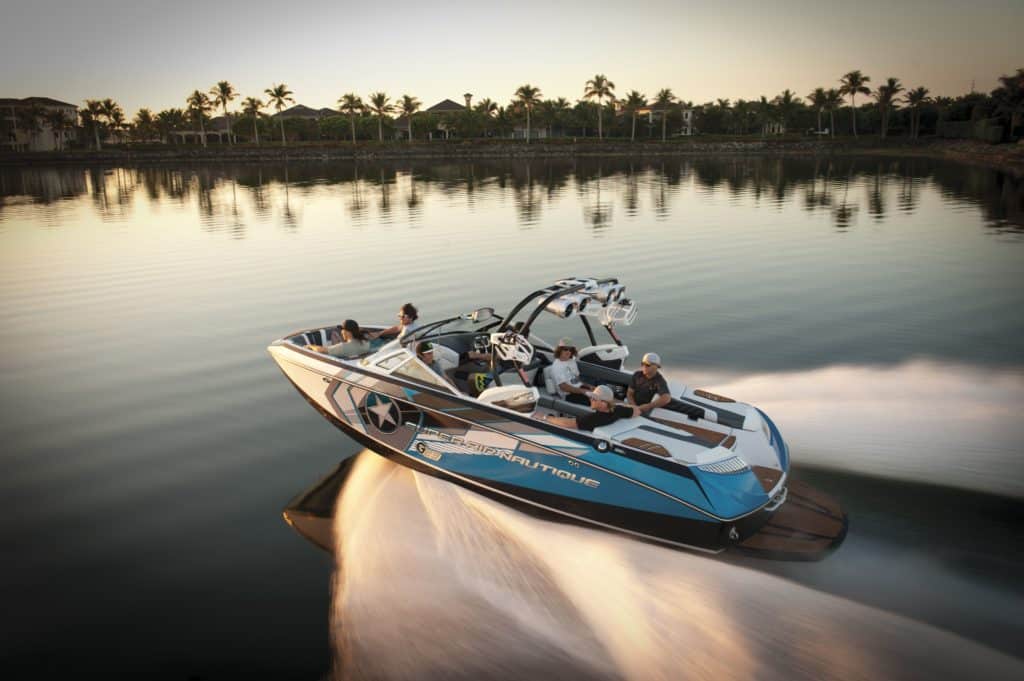
With a dry weight of 5,400 pounds and more than 2,800 pounds of subfloor internal ballast, the Super Air Nautique G23 is a wake-making monster right out of the factory. If you’ve ever seen a G-Series boat slammed down with internal ballast and a full complement of people, you know what this boat is capable of. To get the kitelike raleys Murray is known for, he adds enough weight to get him up there, and, more importantly, he puts it in the right places.
“On top of stock ballast,” says Murray, “I don’t put that much extra weight in. In fact, the weight I add is only a replacement for passengers since I keep it weighted for a driver and a spotter.” Murray puts almost half that replacement weight in the back, on either side of the motor box, and about two-thirds as much in the bow and none in the middle if he has passengers. He uses water in the back and lead everywhere else. The G23’s subfloor internal ballast leaves plenty of seating room and storage space, so Murray opts for lead in the middle and the front to keep everything hidden. “Lead is convenient for space,” says Murray.
If you pay for lead from a store, you’ll probably get dinged with a price of about $1 per pound. That starts to add up quickly if you aim to get any significant amount of extra weight in your boat. Instead, Murray devised a system to get his lead for free.
“Go to tire stores and get the used counterbalance weights they use on rims and put them in a 4-inch PVC pipe that’s about 2 or 2 1/2 feet long from Home Depot,” he says. “Then put some end caps on and you end up with a 50-pound piece of pipe. Just go to the tire stores with a 5-gallon bucket and ask them for it, and if you go to enough stores you’ll eventually get it all for free.”
TREVOR HANSEN — SUPRA SA350-550
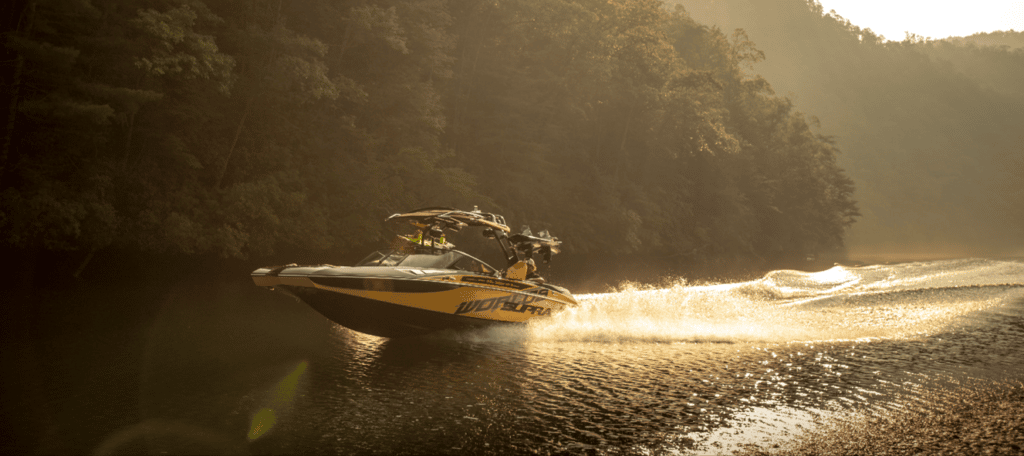
Supra’s new SA350-550 has the capacity for a monster wake straight out of the box. With a dry weight of 4,300 pounds and 2,200 pounds of ballast available from the factory, the SA has very respectable stock ramps. However, if you want to add more weight, it’s important to do it right. “As a general rule,” says Hansen, “the SA likes about 60 percent of the weight in the back and about 40 percent in the front.” Hansen uses a combination of metal and water but is actively working toward using exclusively metal to create more space in the boat.
“I’ve been using workout weights, and I paint them so they don’t rust,” says Hansen. “I’ve made some of my own lead too by melting down tire weights. I haven’t done it in a long time, but when I was younger, I used to melt down the tire weights in a turkey fryer. I fired it up on high and it would melt a full pot of lead in about 15 minutes. Then I would pour the contents into a pretty good-size bread pan, let it harden and then dump it out and you end up with about a 50-pound brick. I wouldn’t recommend this because breathing lead fumes is really bad for you. Now I go on Craigslist and buy workout weights or Play It Again Sports and used places. I try to never pay more than 50 cents per pound.”
STEEL LAFFERTY — MASTERCRAFT X-STAR
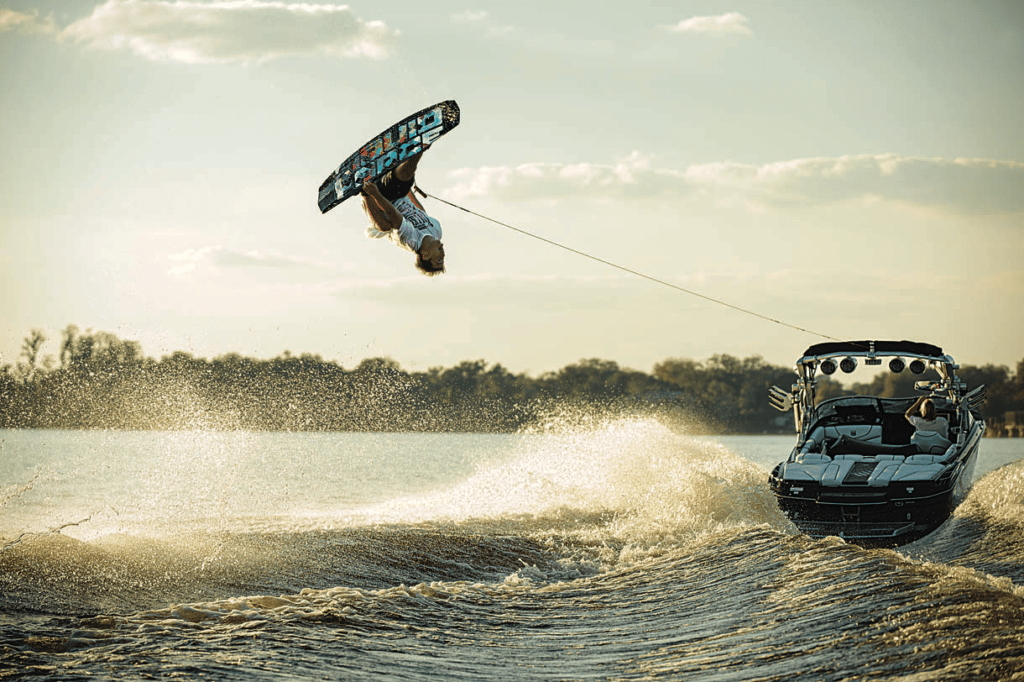
Chances are, the 2013 X-Star’s reputation precedes it. With new tricks constantly being landed behind it, you know the wake has to be capable of epic proportions. At 24 feet in length with a dry weight of 5,400 pounds, it’s one of the beefiest flagship wakeboard boats out there, and with another 2,400 pounds of available factory ballast, you’re getting a world-class wake without additional weight. A rider like Lafferty is pioneering the sport’s newest tricks, and he likes to get every inch out of his wakes. “With the new X-Star, I like to put weight in the back,” says Lafferty. “It gives it that extra little lip. I can honestly ride the new X-Star without any extra weight in it, but I just like to tweak it for how I like to ride.” Lafferty distributes the weight a bit more to the back for the added pop he likes.
Like the other pro riders, Lafferty had to get creative in obtaining his lead weights. “I have a bunch of 50-pound bars,” he says. “My dad has an air conditioning company, and it had a bunch of lead sitting around, so I just grabbed it.” Nepotistic larceny — nice work, Steel.
CHAD SHARPE — MALIBU WAKESETTER 22 MXZ
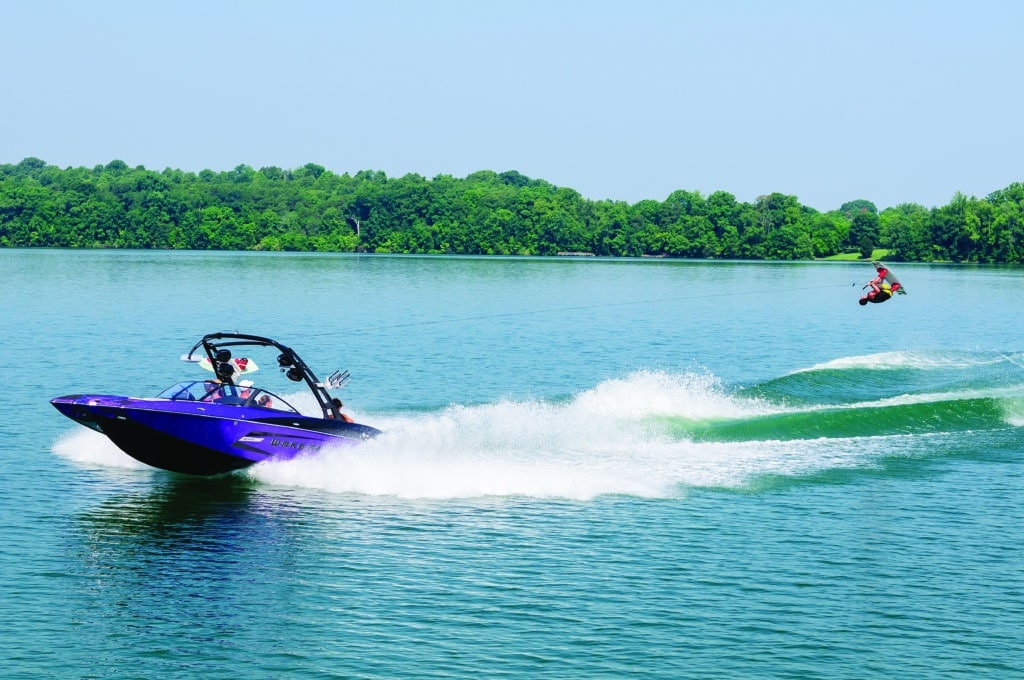
For a 22-footer, the Malibu Wakesetter 22 MXZ is a heavy boat. And that’s a good thing when it comes to sheer wake-making promise. At 4,400 pounds with 2,400 pounds of ballast, the 22 MXZ has plenty of potential, and Sharpe uses every bit of that potential.
“In the 22 MXZ, I run all the stock ballast with the Wedge all the way down, and then I run a little more weight in the front than the back,” says Sharpe. “Probably about 55 to 45 . The sacks in the back are Plug N Play and plumbed in. I have three 80-pound bars, and those just get moved around as people get moved around.” Sharpe runs mostly water in his boat and for good reason. “I pull the boat in and out of the water a lot for cleaning and servicing, so lead is a lot of work,” he says. “Lead is easy to hide, but water is quick. This is the first boat I’ve had with plumbed-in sacks, and it’s really nice. It’s the flip of a switch. You don’t have to deal with any hoses or anything else, you just check on them and make sure they’re full and you’re good to go.”
DEAN SMITH — AXIS A22
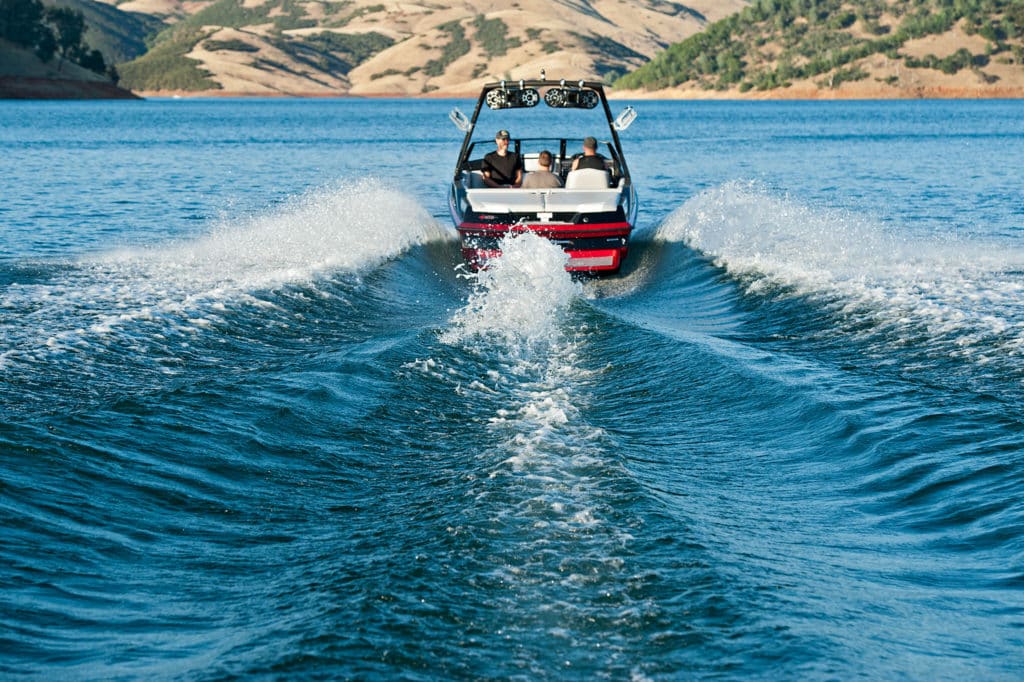
Smith rides behind the no-frills, rider-inspired Axis A22 and by all accounts has a slamming wake. If you’ve seen Smith’s hard-charging, into-the-flats style of riding, then you know what the A22 is capable of with the right rider in tow. “The wake is super meaty,” says Smith. “Different boats demand different weight setups. I find that the A22 is best loaded slightly toward the front to find that sweet spot. All boats are different, so take the time to set up your boat safely.”
RICKY GONZALEZ — CENTURION ENZO FX-22
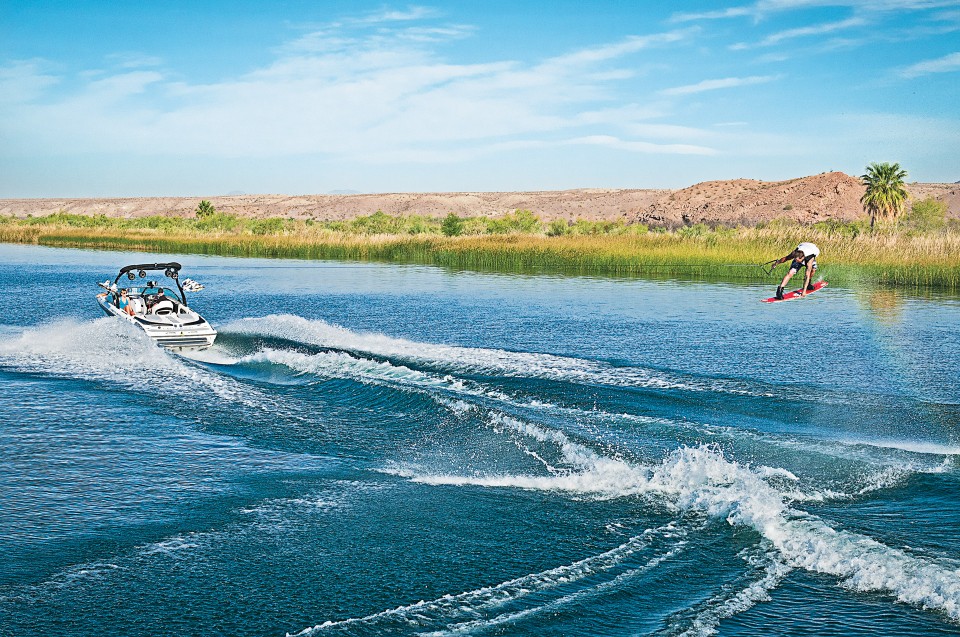
Centurion’s new FX-22 is a big step forward for the company in terms of legit wakeboard performance with massive factory ballast. The FX-22 is a big, heavy, solidly built boat weighing in at 4,400 pounds with available factory ballast tipping the scales at 4,200 pounds. West Coast legend Ricky Gonzalez shreds behind the FX-22 and uses a convenient rule of thumb as a starting point for any boat he weights: “I weight my boat evenly,” says Gonzalez. “You want the boat to be sitting level in the water or just a little higher in the front. The front is the biggest part of the hull’s V, so you want that to be pushing the water and making the wake.” If there are too many passengers for his weighting configuration, Gonzalez will take a little weight out of the front, but, generally, balanced front-to-back weighting will get him close to the wake he’s looking for.
ERIK RUCK — TIGÈ Z3
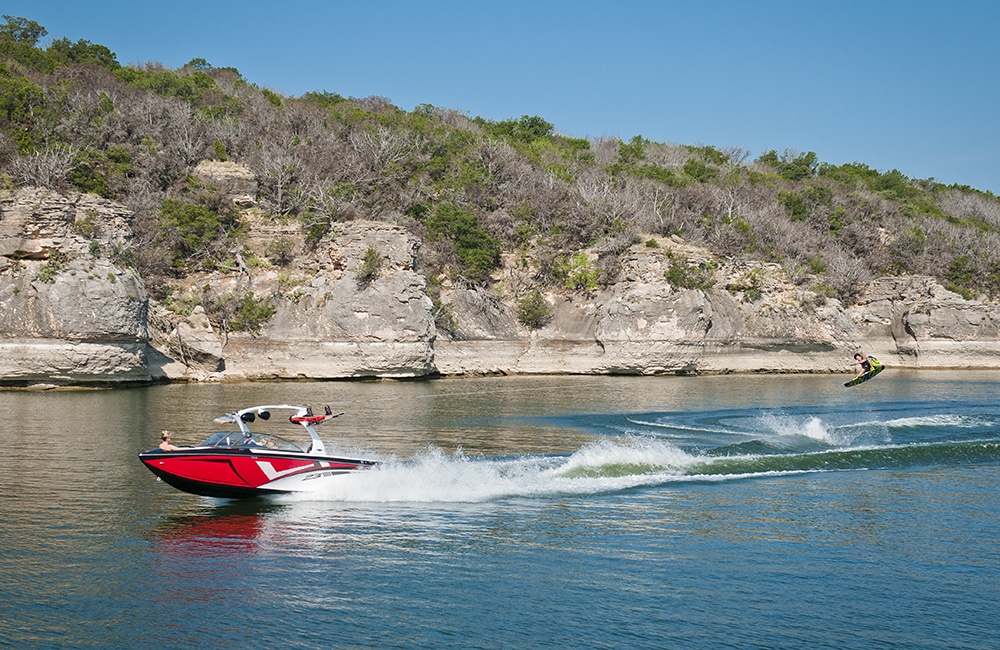
With a hefty dry weight of 4,640 pounds and the best hull Tigé has ever built, the Z3 has a lot going for it. Massive factory ballast options make for a substantial wake straight out of the gates, but if you want to add more weight, make sure to take Erik Ruck’s advice. “The Z3 definitely has its cleanest wake when you have a little more weight in the nose,” says Ruck. “Just make sure it’s evenly weighted from side to side, don’t overweight the back and you’ll have a sick wake. I use water because I’m not a big fan of lugging stuff around, and I generally fill and unfill things quite a bit because I’m switching from surfing to riding, so it’s easier and more convenient.”
ADAM FIELDS — EPIC 23V
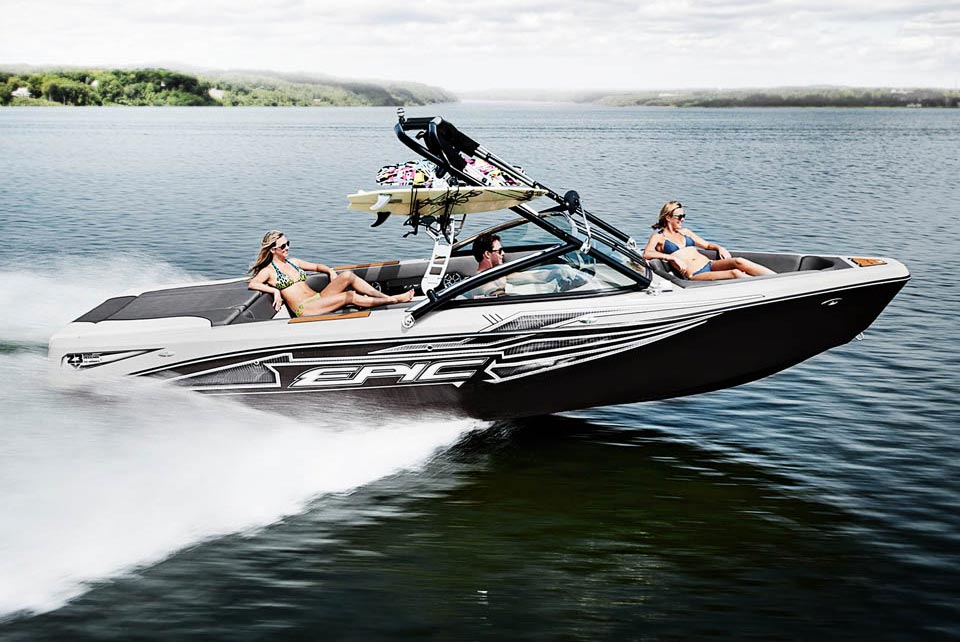
Epic is somewhat of a unique animal within the inboard world because the company pioneered the use of massive amounts of subfloor ballast — 4,000 pounds, to be exact. That said, the boat has a dry weight of 3,900 pounds, so to fill the entire stock ballast, you’d be looking at almost four tons of displacement plowing through the water, and with Epic’s unique hull shape, it might be a bit much for even the pros.
“A mistake people make when they ride behind an Epic boat is they fill all the ballast,” says Adam Fields. “I can do all my tricks, and I’ve progressed on my boat, and I never even fill the ballast all the way. You don’t need any extra sacks if you’re a wakeboarder. Epic uses three tanks, and they’re all under the floor of the boat. I weight it just a little heavier on the port side to offset the torque from the prop. I like to have a pretty even distribution , or maybe even a little stern-heavy. The last thing you want to do if you have five or six people in your boat is fill the ballast more than halfway or three-quarters. My three-invert to five-invert guys will love the wake with about one-quarter ballast. It is just an amazingly effective boat for making a wake.”
LEAD VS. WATER
We’ve seen plenty of methods to weight a boat down over the years, and they range from the feasible to the downright ridiculous. From portly friends (gross) to buckets of sand (messy) to leaky waterbeds (wet), the techniques have been refined down to a handful of legitimate methods of ballasting a boat. The most common, by far, is water bags, and for good reason. Water is easily accessible (obviously, you’re in a boat), quick, movable, clean and does virtually no damage to your boat. You can have thousands of pounds of water weight in your boat for years and it can look as if you hadn’t added an ounce. Another choice, lead, is favored by many pros because it’s easily hidden (so they can get more chicks in the boat) and incredibly heavy for its size. A drawback — as you read about Shaun Murray’s tire store panhandling — is that it’s not easily accessible for a reasonable price. Another potential downside to lead is that it’s not soft, like a ballast bag, so it could cause damage to your boat’s floor after repeatedly slamming down when you go through rollers. Finally, as Chad Sharpe pointed out, if you’re constantly pulling your boat out for cleaning and servicing, it could be a pain to keep transferring weight out when you could just hit a button and drain water from sacks.
